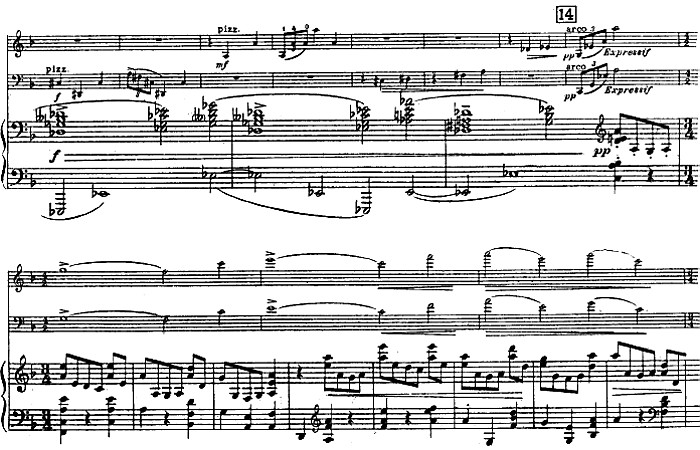
P antoum poetical form—where each subsequent line changes function to become an antecedent line in the next stanza. Ravel’s music shows a love of the musical equivalent of this, playing on in-built ambiguities between antecedent and consequent to build up large-scale forms and at the same time hold our attention by letting the ambiguities surprise us.”T he Morgenstern Trio (Catherine Klipfel, piano; Stefan Hempel, violin; Emanuel Wehse, cello) have a uniquely intense, incisive style, as was abundantly demonstrated in their performance of Debussy, Mozart, and Brahms in a Music Alliance Series program Friday evening.
— Roy Howat, 1993.
T he trio also have a characteristic, wry sense of humor, as befits the eponymous Christian Morgenstern, a German poet who was born in 1871 and died of TB in 1914.
T he Trio’s whole performance was superb—fresh; exciting; technically flawless—no surprise, given the many prizes they have received in competitions.
B ut even their encore—the second movement of Ravel’s piano trio, entitled ‘Pantoum’—delivered more, more than one routinely expects from an ‘encore’. The piano opens with the edgy, intense first theme, and the strings respond in double octaves. The short scherzo and trio ‘A-B-A’ structure makes for a perfect encore-length morsel. But there are ironies and meta-meanings in this piece. The repetitions and surface-level structures of the piece are not as straight-forward as they seem. The structure is like a ‘spell’ cast by a witch in a folktale. The rhetoric is one not of declamation but enchantment.
R avel wrote the trio theme in a completely different metre (4/2) from the scherzo (3/4), and the two time signatures co-exist—a kind of metrical dissonance that adds a lot of drama to an otherwise ‘dèpouiller’ (‘pared-down’, to the level of a children’s fairytale) narrative.
T he ‘piano-against-strings’, ‘4/2 vs. 3/4’ meter switches with the 4/2 that is initially in the piano part later swapped as the strings go from 3/4 to 4/2 and the piano returns to 3/4. The “competing meters” metrical dissonance persists for a long, long stretch: 168 quarter notes at 192 bpm, almost a whole minute’s worth.
 T he ornaments are ‘reflexive’, as if they are compulsory, happenstantial features of how the music lays under the physical hand for each instrument, and as contrasted with a fully-deliberated, polished, composerly gesture.
T he ornaments are ‘reflexive’, as if they are compulsory, happenstantial features of how the music lays under the physical hand for each instrument, and as contrasted with a fully-deliberated, polished, composerly gesture. T he reflexive, organic sounds wash over us, and we develop a suspicion of ambient, non-human order; a sense of diabolical, out-of-control natural forces at-work; a mix of awe and wonder and foreboding.
T he tension between the different meters—the different time percepts—inducing us to switch between an ‘ensemble algorithmic level’ and an ‘individual voice level’ depending on what is more significant or more commanding of our attention—is the primary reason why this ‘Pantoum’ movement is so exciting, I believe. In the languid section between numbers 11 and 15 in the score, the trio “sound grains” are large, and the listener attends to the ensemble sound and its algorithmic metrical structure.
B ut in the emphatic pizzicato passages, our attention is absorbed in the motion of the individual string parts, and we suspend attending to the algorithmic interactions associated with the metrical dissonance.
T he metrical dissonance persists and “lurks”, though. It is still within our awareness—and we feel apprehensive about the finiteness of our attention and the risks that might come true on account of shifting our attention away from the metrical dissonance “ensemble” features and onto the individual parts, much as a child hearing a fairytale experiences apprehension as her attention is absorbed by some new story development but the wolf is without doubt still in those woods and nightfall is not long off.
O ne may say that the number of functions is extremely small whereas the number of characters is extremely large. This explains the two-fold quality of a folktale—its amazing multiformity, picturesqueness, and color... and, on the other hand, its no-less-striking uniformity—its repetition.”I t captivates us—it fully absorbs us, this fairytale-like pantun of Ravel’s—all the way to its ending flourish. We are spell-bound, returned to a primitive state of wonder, feeling much like we felt as children listening to thrilling stories—ones we had never heard before—told to us by belovèd grandparent or parent. You don’t get this entrancing music experience from recordings—not really. You need to attend a “live” performance, like the especially fine one given by Morgenstern Trio Friday night!
— Vladimir Propp, Morphology of the Folktale, p. 20.
L ass die Moleküle rasen,
was sie auch zusammenknobeln!
lass das Tüfteln, lass das Hobeln,
heilig halte die Ekstasen.
[Let race the molecules,
tossing together what compounds they may!
Let the random tinkering continue; let the atoms’ planes and dihedral angles,
Keep holy the ecstasy.]”
— Christian Morgenstern, Lass die Moleküle rasen.
- Morgenstern Piano Trio website
- Ravel Piano Trio score at IMSLP.org
Justice D. Pantoum of the Great Depression. New Yorker, 1994. - Sim K. More than a Pantum. Times, 1987.
- Pantun.com
- Morgenstern Trio. Smetana/Shostakovich/Bernstein Trios. (Azica, 2011.)
- Morgenstern Trio. Beethoven/Brahms Trios. (Telos, 2010.)
- Morgenstern C. Lullabies, Lyrics, and Gallows Songs. (Zwerger L, tr.) Neugebauer, 1995.
- Morgenstern C. Songs from the Gallows: Galgenlieder. (Arndt W, tr.) Yale Univ, 1993.
- Christian Morgenstern page at Wikipedia
- Morgenstern C. Die Versammlung der Nägel. Public domain, 1910.
- Christian-Morgenstern.de
- Betelheim B. The Uses of Enchantment: The Meaning and Importance of Fairy Tales. Vintage, 2010.
- Caroll N. The Philosophy of Horror: Or, Paradoxes of the Heart. Routlege, 1990.
- Cassels J, Fröhlich A, eds. Algebraic Number Theory. 2e. LMS, 2010.
- Cohen H. Number Theory: Volume I: Tools and Diophantine Equations. Springer, 2007.
- Duverney D. Number Theory: An Elementary Introduction Through Diophantine Problems. World Scientific, 2010.
- Friedlander J, et al., eds. Analytic Number Theory. Springer, 2006.
- Gyary K, et al., eds. Number Theory: Diophantine, Computational and Algebraic Aspects. de Gruyter, 1998.
- Howat R. Ravel, rhythm, and form. Musicology Australia 1993;16:39-48.
- Howat R. Debussy in Proportion: A Musical Analysis. Cambridge Univ, 1986.
- Howat R. The Art of French Piano Music. Yale Univ, 2009.
- Krebs H. Fantasy Pieces: Metrical Dissonance in the Music of Robert Schumann. Oxford Univ, 2003.
- Lehmer Sieve at Wikipedia
- Lehmer D. Hunting big game in the theory of numbers. Scripta Mathematica 1932:1:229-35.
- Lüthi M. Once Upon a Time: On the Nature of Fairy Tales. Indiana Univ, 1976.
- Newbould B. Ravel’s 'Pantoum'. The Musical Times 1975;116:228–31.
- Propp V. Morphology of the Folktale. 2e. Univ Texas, 1968.
- Vojta P. Diophantine Approximations and Value Distribution Theory. Springer, 1987.

D iophantine Pantoum where A=7, B=3
1Lehmer sieve’s ribbon o’er Diophantine field;
2White paper slides to the tune of rods’ switches.
3Sieve sings congruences, linear aria concealed,
4Seeks solutions to be found in theory which, as
2White paper slides to the tune of rods’ switches,
5Ribbon infers nineteen B minus eight A equals one.
4Seeks solutions to be found in theory which, as
6A father’s age AB is one less than twice BA the son,
5Ribbon infers nineteen B minus eight A equals one.
7Polynomial conjecture, in Fermat’s margin centuries’ toil!
6A father’s age AB is one less than twice BA the son
8Yields seventy-three and thirty-seven, algebraically closed foil.
7Polynomial conjecture, in Fermat’s margin centuries’ toil!
3Sieve sings congruences, linear aria concealed,
8Yields seventy-three and thirty-seven, algebraically closed foil—
1Lehmer sieve’s ribbon o’er Diophantine field.”
— DSM.
No comments:
Post a Comment